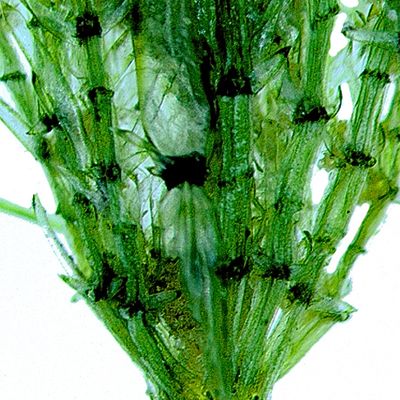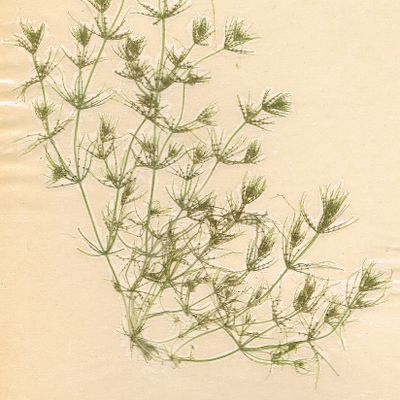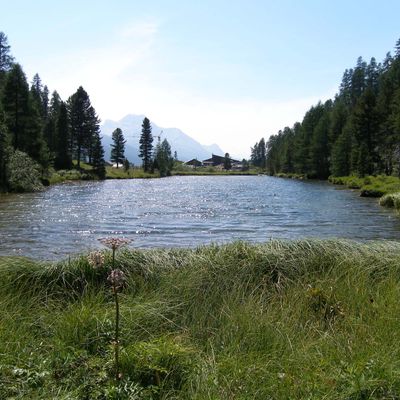Chara tenuispina A. Braun
50023
Species
ISFS :
Checklist : 50023
ISFS :
Checklist : 50023
Contains :
Synthesis
NO INFORMATION
Habitat and distribution inside Switzerland
Status
IUCN status
Critically endangeredNational Priority
2 - high national priorityInternational responsibility
1 - weakConservation
Threats
Habitatverlust
Mangel an Dynamik in aquatischen Lebensräumen
Gewässereutrophierung
Wissenslücken
Distribution map
Habitat and distribution inside Switzerland
Ecology
Life form
Habitats
Milieux Phytosuisse (© Prunier et al. 2017)
Habitats © Delarze & al. 2015
| NO INFORMATION |
bold
Dominant species, influencing the appearance of the habitat
 Character species
Character species
 Less strictly linked to a specific habitat
Less strictly linked to a specific habitat
Ecological indicator values by © Landolt & al. (2010)
| Soil factors | Climatic factors | Salinity tolerance | |||
|---|---|---|---|---|---|
| Humidity Value H | -- | Light Value L | -- | Salinity Index | -- |
| Reaction Value R | -- | Temperature factor T | -- | ||
| Nutriments value N | -- | Continentality K | -- | ||
- Ecological values legend
Humidity Value H 1 very dry 1+ dry 2 moderatly dry 2+ moist 3 medium wet 3+ wet 4 very wet 4+ soggy 5 submerged or underwater f plants living in running water u mostly submerged plants v partly submerged, partly floating plants w humidity moderately variable (± scale of 1-2) w+ highly variable humidity (scale exceeding ± 2) Reaction Value R 1 Very acid (pH 2.5-5.5) 2 acid (pH 3.5-6.5) 3 lightly acid to neutral (pH 4.5-7.5) 4 neutral to basic (pH 5.5-8.5) 5 basic (pH 6-5 -> 8.5 Nutriments value N 1 very low in nutrients 2 low in nutriments 3 medium-poor to medium-rich in nutrients 4 rich in nutriments 5 very rich in nutriments Salinity tolerance 1 halotolerant 3 halophyle Light Value L 1 very shady 2 shady 3 lighted areas 4 luminous 5 highly luminous Temperature factor T 1 alpine to nival stages (from the treeline to the snowline) 1+ suprasubalpine and upper subalpine levels (pine and larch forests) 2 subalpine level (coniferous forests without beeches up to the upper limit of spruces) 2+ lower subalpine and upper mountain stages 3 mountain level (beech and silver fir forests, in the central Alps Scots pine forests) 3+ lower mountain and upper hill levels 4 hill level (mixed deciduous oak forests) 4+ hot places, hill level 5 very hot places, hill level (only in the hottest places, typical of southern Europe) Continentality K 1 Atlantic (high air humidity, very low temperature variations, mild winters) 2 Sub-Atlantic (high air humidity, low temperature variations, relatively mild winters) 3 sub-Atlantic to subcontinental (average air humidity, moderately variable temperature, slightly low winter temperatures) 4 subcontinental (low air humidity, large temperature variations, rather cold winters) 5 continental (very low air humidity, very large temperature variations, cold winters)
Water dependency
| Rivers | 0 - No link |
| Calm water | 2 - Essential habitat |
| Ground water | 0 - No link |
Nomenclature
Accepted Name (Checklist 2017)
Chara tenuispina A. Braun
Vernacular name
Deutscher Name :
Dünnstachelige ArmleuchteralgeNom français :
--Nome italiano :
--Match with other reference books
| Relation | Nom | Book | No |
|---|
= The taxon corresponds to the accepted taxon (Checklist 2017)
< The taxon is included in the accepted taxon (Checklist 2017)
> The taxon includes (among others) also the accepted taxon (Checklist 2017)
< The taxon is included in the accepted taxon (Checklist 2017)
> The taxon includes (among others) also the accepted taxon (Checklist 2017)
Status
Native status
-IUCN list of endangered species (© Walter & Gillett 1997) : No
Status on national Red List 2012
IUCN status:
Critically endangered

Additional information
IUCN criteria: --
Status on regional Red List 2019
| Biogregraphic regions | Status | IUCN criteria |
|---|
- Legend
EX Extinct RE Regionally Extinct CR(PE) Critically Endangered, Probably Extinct CR Critically Endangered EN Endangered VU Vulnerable NT Near Threatened LC Least Concern DD Data Deficient NE Not Evaluated NA Not Applicable
National Priority Species List Status
| National Priority | 2 - high national priority |
| Need to take action | 1 - |
| International responsibility | 1 - weak |
| Need to monitor populations | 2 - |
Protection status
| International (Bern Convention) | No | |
| TI | total protection | (23.01.2013) |
| Switzerland | -- |
- Disclaimer
InfoFlora compiles information on protected species as accurately as possible, taking it from the respective cantonal laws. In some cases, however, it was not possible to use the plant names as listed in the original text, but an interpretation of their taxonomy or nomenclature was necessary. The exact meaning of the categories „completely protected“ and „partially protected“ differs among the cantons.
InfoFlora cannot guarantee that the information on the protection status is correct and complete. In case of doubts, we recommend to look up the texts of the respective cantonal law.
Status by sector of activity
| Agriculture-related environmental objectives : | more informations | |
| Forest management environmental objectives : | more informations |
Conservation
Threats and measures
Habitatverlust
Natürliche Seeuferabschnitte erhalten, besonders in Gewässern mit natürlichen Wasserstandsschwankungen, die eine Vielfalt von geeigneten Milieubedingungen schaffen.
Mangel an Dynamik in aquatischen Lebensräumen
Eine natürliche Gewässerdynamik wiederherstellen, sodass Pionierlebensräume entstehen können. Dafür mehr Raum bereitstellen.
Neue Stillgewässer unterschiedlicher Grösse und Tiefe anlegen, die im Sommer trockenfallen können.
An geeigneten Gewässern Pionierstandorte durch abschnittsweises Entfernen der Vegetation und Freilegen des Substrats schaffen.
Gewässereutrophierung
Die Nährstoffkonzentration auf einem mesotrophen Niveau halten, aber eine Eutrophierung vermeiden.
Im Uferbereich breite Pufferstreifen mit Sumpf- und Gebüschzonen, Hecken- und Waldstreifen usw. erhalten.
Verhindern, dass grosse Nährstofffrachten über Oberflächenabflüsse, Drainagen usw., ins Gewässer gelangen.
Sowohl im Einzugsgebiet als auch in der unmittelbaren Umgebung des Gewässers eine extensive Bewirtschaftung mit den Instrumenten der Landwirtschaftspolitik fördern.
Wissenslücken
Die Entwicklung bekannter Bestände überwachen und die Kenntnisse über die Ökologie und die Biologie der Art vertie-fen.
Ausgehend von den bisher bekannten Standorten nach weiteren Vorkommen der Art suchen.



